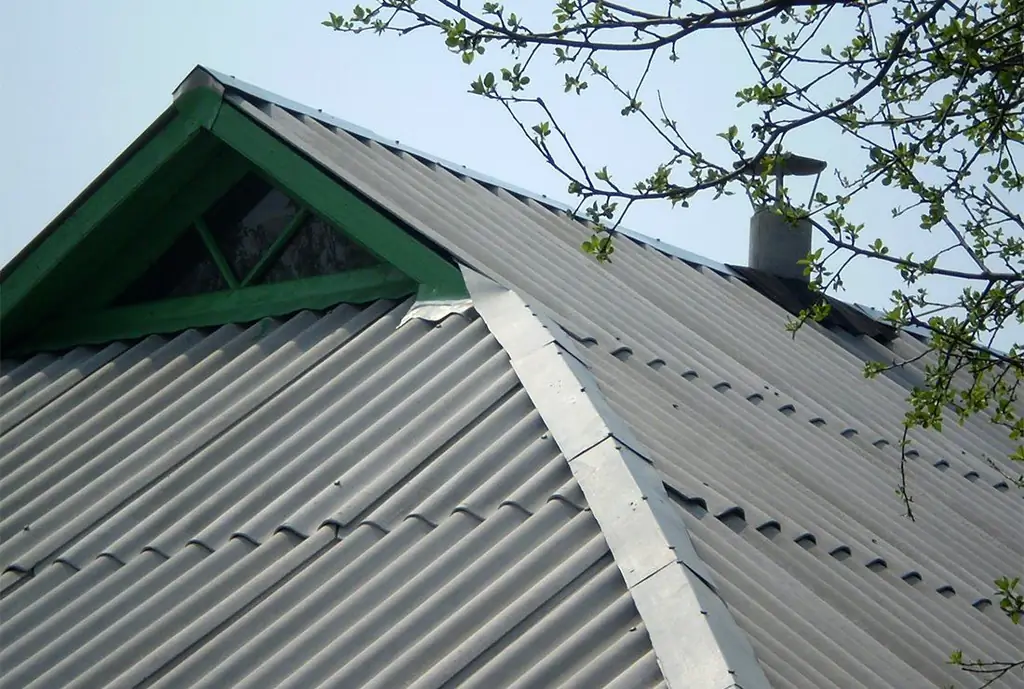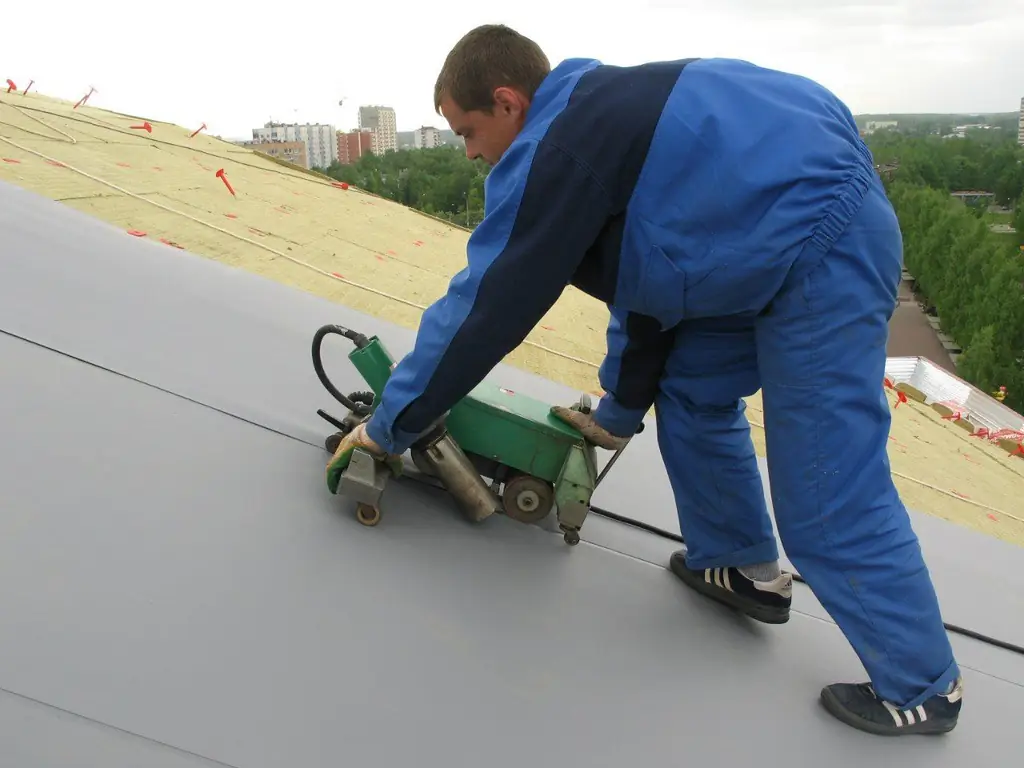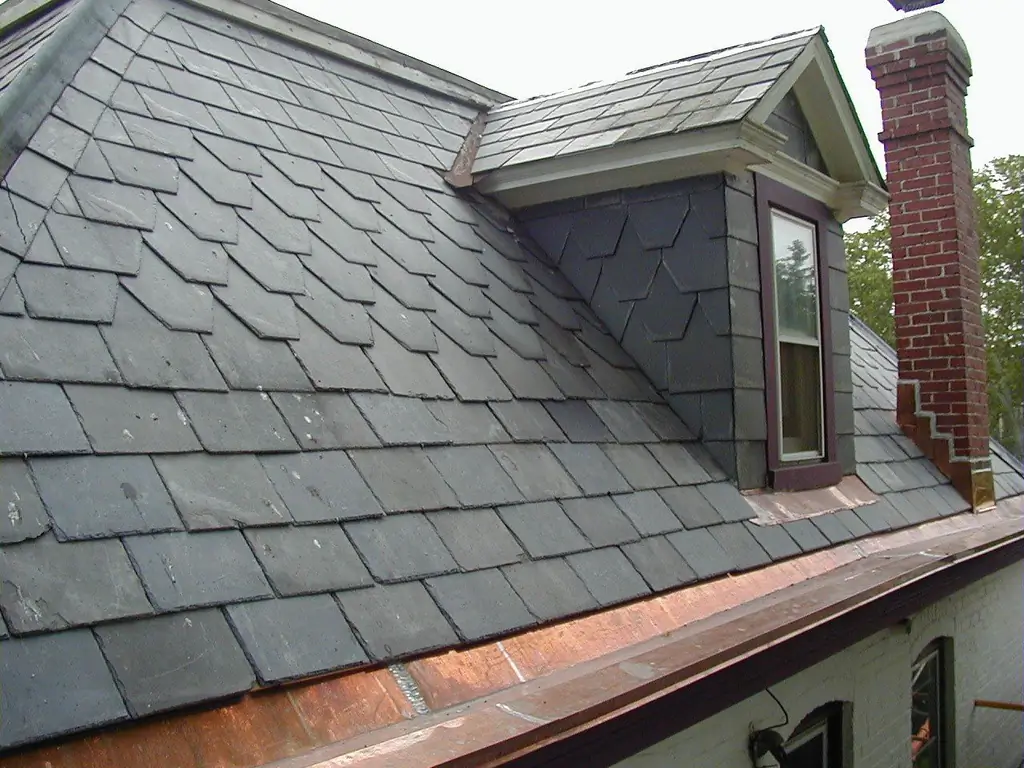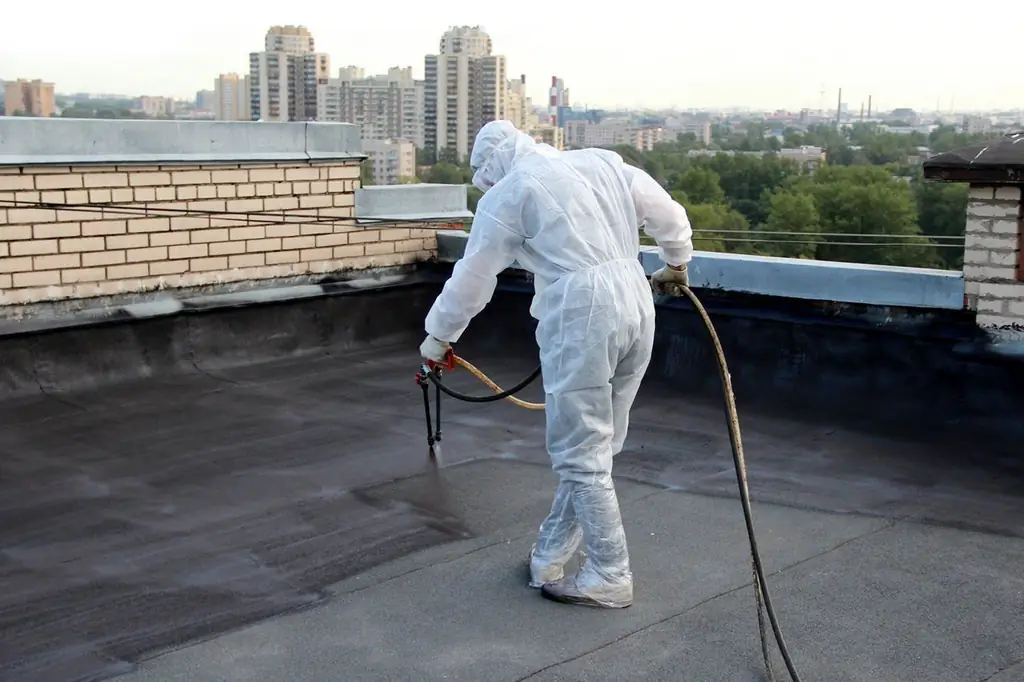
Table of contents:
- Author Bailey Albertson [email protected].
- Public 2023-12-17 12:53.
- Last modified 2025-01-23 12:41.
Features of the slate roof: we reveal the secrets of the material

Over the past 10 years, many different types of roofing materials have appeared on the market, but nevertheless one of them has the greatest demand and is the market leader. And this material is slate. It has optimal service life, low price, sufficient functionality and quality. The high level of reliability of the roofing material ensures comfort and coziness in the house, as well as good weather protection.
Content
- 1 Slate roof: its features and characteristics
-
2 Slate roofing device
- 2.1 Slate lathing
- 2.2 Slate roofing cake
- 2.3 Slate roofing elements
-
3 Features of installing a slate roof
3.1 Errors during installation of a slate roof
-
4 Features of the operation of a slate roof
4.1 Service life of roof slate sheet
- 5 Video: how to cover the roof yourself with slate
Slate roof: its features and characteristics
Slate has been used in construction for a very long time and is still widely used.

Slate is one of the most popular roofing materials
Natural slate - rock plates, the main component of which is clay shale, from which the name of this material came ("schiefer" - from the German "shale"). Natural slate began to be used in construction in the Middle Ages, and still in Europe there are houses with a roof made of this material.
Slate sheets are flat or wavy.

Flat slate has a slightly different structure than wave
To ensure the rigidity of flat sheets, chrysolite fiber is used as a reinforcing element. This type of slate is usually used for the construction of various fences and in wall panels in order to increase their thermal insulation properties.
Wave-shaped slate is mainly used as a roofing material. Modern technologies have made it possible to increase the service life of the material and give it a more aesthetic appearance. The width of a sheet is measured by the number of waves (six, seven or eight), and the length is often a standard size.
Positive traits:
- the service life reaches 50 years and more;
- ease of installation in comparison with other materials, which ensures a fairly short time frame for roofing works;
- high water resistance, which provides excellent protection against moisture;
- resistance to large drops in air temperature;
- high strength, which allows it to withstand high snow loads in winter;
- low specific weight (ratio of weight to overall dimensions);
- resistance to fire, but exposure to high temperatures for a long time is unacceptable;
- resistance to solar radiation;
- good sound insulation properties;
- low cost;
- the surface is paintable;
- well machined, so you can use a conventional hacksaw;
- the use of a vapor barrier is not necessary, since practically no condensation forms on the surface of the slate.

Slate can be used to cover the roof of a house or outbuildings
It may seem that, having so many advantages, slate will not have serious disadvantages, but it cannot be called an ideal material.
Negative qualities:
- The slate sheet is very fragile, making it difficult to transport. Due to the disproportionate thickness in relation to other sizes, it is recommended to move slate sheets in a vertical position, otherwise it will simply crack under its own weight.
- Over time, the level of water resistance of the slate decreases due to the erosion of the material.
- Lichens begin to sprout on the slate sheets, on which the shadow of trees or other structures constantly falls, and mold forms.
- The color of the material gradually changes under the influence of weather conditions.
Today there are three types of material on the market, the sheets of which have a wavy shape and are called "slate":
-
Made of metal. The most commonly used name is corrugated board. In the manufacture of metal slate, galvanized sheets with polymer spraying are used to protect against corrosion.

Metal slate Slate can be made not only from asbestos
-
Made of asbestos. Asbestos fiber has greater strength than steel when used as a cement binder. Asbestos fibers, distributed over the entire area of the sheet, working as a reinforcing mesh, provide high impact strength and strength of the material.

Asbestos slate Colored asbestos slate looks very aesthetically pleasing
-
Euroslate. It is mainly composed of cellulose, fiberglass, basalt fiber, or jute. Euroslate based on asbestos-free bitumen or galvanized has not gained the same popularity as a slate sheet made from an asbestos-cement mixture.

Euroslate Euroslate has a special composition
Slate roofing device
When starting roof installation work, make sure that the rafters meet the requirements of the roofing material. The slate is heavy and the rafter system must withstand the following loads:
- the total weight of all materials used;
- wind and snow loads;
- the mass of a person performing installation or repair work.
Slate lathing
Since asbestos-cement slate has a large mass, the crate must be made with high quality. The ideal cross-section of the batten is from 50 to 75 mm. A bar less than 50 mm can crack, and a bar over 75 mm is subject to deformation from high humidity - it begins to twist.

The lathing must support the weight of the slate
When the sheets are overlapped, the odd bar is fixed 30 mm below the even bar.
Slate roofing cake
In the construction of all flat or pitched roofs, a large number of layers of various materials are used, which provide protection of the attic or attic space from the effects of precipitation and temperature changes.

It is recommended to lay both waterproofing and vapor barrier layers and insulation under the slate.
Roofing Pie Layers:
- interior decoration of the premises;
- lathing from a bar;
- steam insulation;
- counter-lattice;
- thermal insulation;
- ventilated space;
- roof material.
Any layer, mounted in accordance with all the rules, fulfills its specific task and ensures the normal functioning of the entire roof as a whole. Violation of the installation rules or non-compliance of any material with the requirements of weather conditions leads to the fact that the roof will have to be redone.
Slate roofing elements
In order to seal the places where the roof has fractures (ridge, valleys), places where the elements of the structure of the house (chimney and ventilation channels, walls) exit from precipitation, additional elements are used. Sometimes such an element contributes to the ventilation of the roof, and sometimes completely ensures the tightness of the roof.

For a ridge, it is better to choose galvanized steel slate
In general, for a slate roof you will need:
- Skate. It is a corner piece. For a slate roof, it is recommended to choose a metal ridge. Its main function is to protect against moisture and dust from entering the roof. It also performs a decorative function.
- Endova. It is used to remove moisture from the roof slope. It can be internal and external. It is fastened between the slopes in the most vulnerable places of the roof.
- Sealing elements. They are located at the exit points of chimneys, television antennas and ventilation systems. They are flexible materials that adhere closely to the slate. They also perform an additional function - they prevent the displacement of the roofing material due to its expansion and contraction.
- Ebb tide. This type of additional elements is designed to remove excess moisture from the walls of the house.
The variety of roofing is currently very wide. A flat roof made of galvanized sheets, copper sheets or sheets coated with zinc-titanium alloy, which is assembled directly on the construction site, is a single whole, where all elements of an individual size are joined together with a seam joint. In such roofs, each element can be made in any configuration, and the need for additional elements disappears. But roofs made of asbestos-cement sheet do not have such a variety of elements. There are only skates on the market. Asbestos-cement sheet is rigid, therefore the ridge is assembled from several parts with a hinge joint. The valleys are protected with a galvanized substrate or a strip of bituminous waterproofing. The ends of the wind elements are upholstered with a board. You can also lay one slate wave on the ridge joint and attach it to the ridge bar. Well, the skate itself is often made of bent galvanized sheet; the skate itself is practically not found from asbestos cement.
Features of installation of a slate roof
When the installation of the rafter system is completed, they begin to lay the roof itself. Since slate is very sensitive to external mechanical stress, walking on its surface is not recommended.
Due to the fact that roofing work when using this material begins from the lower end of the roof, for even laying of the sheets, the thread is pulled along the slope at a certain distance from the end of the rafters. The sizes of the side waves at the edges of the sheet are different. The plant usually marks a smaller wave. Different sizes are provided in order to ensure tight stacking of sheets together.
Installation of the outermost sheet is performed with a larger wave outward. The next one is laid so that its larger wave covers the smaller wave of already laid sheets.

There are different ways to arrange slate sheets on the roof
The order of slate flooring is as follows:
- determination of the starting point for laying - gable overhang;
- the first sheet of slate is being laid;
- installation of several sheets of slate of the lower row;
- stacking several sheets of the top row;
- the sheet of the bottom row is laid again.
The size of the overlap of sheets horizontally is not less than 120 mm, vertically - one wave. The corners on all sheets are cut 125 mm with a metal hacksaw or circular saw. The corners are joined with a gap of a few millimeters.
To fix the sheets, special slate nails are used, which have a large diameter head, due to which a good pressure of the roofing material is ensured and water is prevented from entering under it. Usually one sheet is attached with no more than four nails.

Fastening slate can only be done with special slate nails
To lay slate on the roof according to all the rules, you need to know how to work with fasteners. The rules of work are given below:
-
holes for fasteners are made before laying;

Drilling slate Holes for nails should be made in advance
- the size of the hole is made larger than the size of the fastener by 2-3 mm;
- a sheet with eight waves is attached in the second and sixth waves, and a sheet with seven waves in the second and fifth;
-
the holes are sealed with rubber, silicone or plastic washers;

Slate nail with washer It is recommended to place a rubber pad under the head of the nail
- the nail is hammered in with light, frequent blows until the head of the sheet touches.
Often, with self-assembly, self-tapping screws of a large length are used for fasteners, under the head of which a rubber washer is placed. But their installation requires the use of a screwdriver or electric drill, which is not always possible. And labor costs are increasing.
After laying the slate, a ridge is equipped, for which a polymer tape is laid and a ridge element is attached on top of it, which bridges the gap between the slate sheets on opposite slopes. Instead of ridge elements, you can also use two boards connected to each other in the form of the letter G. After the boards are installed, they are painted or galvanized.
If a chimney or ventilation duct opens onto the roof, it is necessary to perform an abutment depending on the presence or absence of waterproofing. In its presence, the steel abutment sheet is installed under the slate sheets and a waterproofing layer, and in its absence - over the slate sheet.

It is better to treat the places around the chimney with steel corners.
Errors when installing a slate roof
The following mistakes can be made:
- Inconsistency of the roof slope angle. Slate sheets are used when the slope has a slope of more than 12 degrees. In regions with a high snow load, the slope must have a slope of more than 25 degrees, and the sheets must be laid on four battens, the distance between which is about 350 mm.
- Replacing one roofing material with another. For example, when trying to replace slate with bitumen tiles, it is imperative to change the structure of the crate, because a smaller step between the beams is required. And in case of replacement with ceramic tiles, it is necessary to change the entire rafter system, since the weight of such tiles is much greater and the system will need to be reinforced. Before starting work, it is necessary to finally select the roofing material that will be installed on the roof.
-
Incorrect trimming of sheet corners. It is required that the trimming of the corners ensures a tight fit of the sheet to the support bar, otherwise the sheet may crack when walking.

Undercut corner of slate In no case should the slate be broken - only cut
- The use of ordinary carpentry nails. To fasten slate sheets, you must use only a special roofing nail or a self-tapping screw with a large diameter head.
- Wrong location of the slate sheet. Fastening is done only in the upper part of the waves. If attached to the lower part, then moisture will simply seep through the sheet, since the water flow flows from the roof precisely along the lower part of the wave.
- Excessive pull of the sheet to the sheathing. There should be a gap of several millimeters between the head of a hammered nail or screwed-in self-tapping screw, since a very tight, tight fit of the fastener will certainly cause cracks in the slate due to thermal expansion of the material.
Features of the operation of a slate roof
The surface structure of the slate sheet is porous, so dust and water quickly accumulate in the pores. Lichens, mosses also grow on the surface and mold forms, which quickly destroy it. To extend the service life of slate sheets, it is necessary to perform the following work:
- inspect the surface for surface damage after winter and before autumn;
- remove accumulated dirt and foliage with a brush, and in winter, remove snow and ice.
Staining is an effective method of protection against destruction. The paint protects the slate from precipitation and cracking. It is ideal to use slate sheets painted directly at the factory for the roof. And in the case of repair work on the roof, the already laid slate or newly laid sheets are painted to replace the destroyed ones.
Slate staining steps:
- Surface priming. Before coating with a primer, the surface is treated with antiseptic solutions. Primer is applied using a paint roller or spray gun. The primer fills the pores and ensures that the paint layer is well-matched to the surface. If applied without a primer, the paint will bubble and lay in an uneven layer.
- Primary staining (base coat). It is applied evenly. All hard-to-reach areas should be painted.
- Finish painting. After the primary layer has dried, a finishing layer is applied, which eliminates irregularities, transitions and streaks.

Painting the slate helps extend the life of the material
In order for the paintwork to last for a long time, painting should be done in dry and warm weather.
Roof painting allows not only to solve the problem of roofing material protection, but also to ensure the harmony of colors of the facade and roof of the building.
Service life of roof slate sheet
The standard slate service life is 30 years. But its safety margin is so great that it often lies on the roof for 50 years or more. The durability of the material is provided by many factors:
- slate is a fairly waterproof material, which allows it to withstand high humidity with heavy rainfall;
- it is slightly affected by solar radiation;
- asbestos fiber is a rather unhealthy material, but it ensures long-term preservation of the integrity of the slate sheet;
- good strength of the material with a low specific gravity ensures the perception of large loads, including snow;
- high thermal insulation properties prevent the formation of condensation on the inner surface of the sheets.
Video: how to cover the roof yourself with slate
Subject to the sequence and quality of installation, a slate roof will last a very long time, because it is not in vain that this material is still popular. And all the work on its installation can be done independently.
Recommended:
Metal Roofing, Including The Features Of Its Design And Operation, As Well As Installation Errors

Features of the device of a metal roof, structural elements. How to properly equip such a roof and avoid mistakes. Operating rules
Membrane Roof, Including The Features Of Its Design, Operation And Repair, As Well As How To Avoid Mistakes During Installation

Technical characteristics, advantages and disadvantages of membrane roofing. Features of installation. Rules for the operation, maintenance and repair of a membrane roof
Slate Roofing, Including The Features Of Its Design And Operation, Repair, As Well As How To Avoid Mistakes During Installation

Features of a slate roof. What installation method to choose and how to choose the right material. Maintenance, repair, service life, how to avoid mistakes during installation
PVC Membrane Roof With Description And Characteristics, Including Features Of Its Installation, As Well As Operation And Repair

What is PVC roofing membrane. The main advantages of this material. Features of installation, operation and repair of membrane roofing
Roof Waterproofing And Its Types, As Well As Features Of Its Design And Installation, Depending On The Roofing Material

What materials can be used to arrange reliable waterproofing of the roof and how to install it
